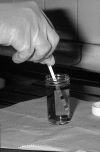Which guidelines can we trust?: Assessing strength of evidence behind recommendations for clinical practice - PubMed (original) (raw)
Review
Which guidelines can we trust?: Assessing strength of evidence behind recommendations for clinical practice
A Liberati et al. West J Med. 2001 Apr.
No abstract available
Figures
Figure 1
Where quality assessment can be carried out and classification of levels of evidence made explicit
Figure 2
Should a healthy 5-year-old child be screened with urinalysis? [Marazzi/SPL]
Similar articles
- Medical Debates and Medical Reversal.
Cifu AS, Prasad VK. Cifu AS, et al. J Gen Intern Med. 2015 Dec;30(12):1729-30. doi: 10.1007/s11606-015-3481-5. J Gen Intern Med. 2015. PMID: 26224155 Free PMC article. No abstract available. - Reduction of urinary catheter use and prescription of antibiotics for asymptomatic bacteriuria in hospitalised patients in internal medicine: before-and-after intervention study.
Egger M, Balmer F, Friedli-Wüthrich H, Mühlemann K. Egger M, et al. Swiss Med Wkly. 2013 May 27;143:w13796. doi: 10.4414/smw.2013.13796. eCollection 2013. Swiss Med Wkly. 2013. PMID: 23740332 - An evidence-based approach to clinical practice guidelines: diagnosis and treatment of irritable bowel syndrome.
Schoenfeld P, Chey WD. Schoenfeld P, et al. Clin Gastroenterol Hepatol. 2003 Jul;1(4):322-7. doi: 10.1053/s1542-3565(03)00139-3. Clin Gastroenterol Hepatol. 2003. PMID: 15017675 No abstract available. - Irritable bowel syndrome: what do the new Rome IV diagnostic guidelines mean for patient management?
Whitehead WE, Palsson OS, Simrén M. Whitehead WE, et al. Expert Rev Gastroenterol Hepatol. 2017 Apr;11(4):281-283. doi: 10.1080/17474124.2017.1292130. Epub 2017 Feb 22. Expert Rev Gastroenterol Hepatol. 2017. PMID: 28276814 Review. No abstract available. - The role of FDG PET in the management of lymphoma: practical guidelines.
Kirby AM, George Mikhaeel N. Kirby AM, et al. Nucl Med Commun. 2007 May;28(5):355-7. doi: 10.1097/MNM.0b013e3280895e34. Nucl Med Commun. 2007. PMID: 17414884 Review.
Cited by
- The emergence of clinical practice parameter guidelines in neuro-oncology: promise of utility tempered with caution.
Linskey ME. Linskey ME. J Neurooncol. 2008 Sep;89(3):359-62. doi: 10.1007/s11060-008-9619-0. J Neurooncol. 2008. PMID: 18712285 No abstract available. - The impact of cancer research: how publications influence UK cancer clinical guidelines.
Lewison G, Sullivan R. Lewison G, et al. Br J Cancer. 2008 Jun 17;98(12):1944-50. doi: 10.1038/sj.bjc.6604405. Epub 2008 Jun 3. Br J Cancer. 2008. PMID: 18521087 Free PMC article. - Measuring inconsistency in meta-analyses.
Higgins JP, Thompson SG, Deeks JJ, Altman DG. Higgins JP, et al. BMJ. 2003 Sep 6;327(7414):557-60. doi: 10.1136/bmj.327.7414.557. BMJ. 2003. PMID: 12958120 Free PMC article. Review. - Evidence, hierarchies, and typologies: horses for courses.
Petticrew M, Roberts H. Petticrew M, et al. J Epidemiol Community Health. 2003 Jul;57(7):527-9. doi: 10.1136/jech.57.7.527. J Epidemiol Community Health. 2003. PMID: 12821702 Free PMC article.
References
- Putting Prevention Into Practice: Clinician's Handbook of Preventive Services: Children and Adolescents—Screening. 2nd ed. US Dept of Health and Human Services; 1998.
- Grilli R, Magrini N, Penna A, Mura G, Liberati A. Practice guidelines developed by specialty societies: the need for a critical appraisal. Lancet 2000;355: 103-106. - PubMed
- Woolf SH, Battista R, Anderson GM, et al. Assessing the clinical effectiveness of preventive maneuvers: analytic principles and systematic methods in reviewing evidence and developing clinical practice recommendations. A report by the Canadian Task Force on the Periodic Health Examination. J Clin Epidemiol 1990;43: 891-905. - PubMed
- US Preventive Services Task Force. Guide to Clinical Preventive Services. 2nd ed. Baltimore: Williams & Wilkins; 1996.
- Moher D, Jadad AR, Tugwell P. Assessing the quality of randomized controlled trials: current issues and future directions. Int J Technol Assess Health Care 1996;12: 195-208. - PubMed
Publication types
MeSH terms
LinkOut - more resources
Full Text Sources
Medical

